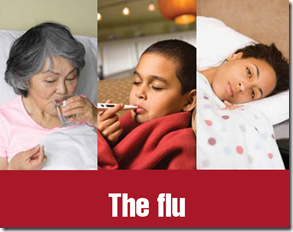Photo Credit CDC Influenza Home Care Guide
# 6745
While it may not tell us a lot about how the rest of the 2012-2013 flu season will go, over the past couple of weeks several states have begun reporting spikes in early influenza activity. The last FluView report from the CDC (Nov 17th) indicated flu activity was increasing in parts of the country; notably in the south central and southeastern states.
Likewise, the Flu Near You weekly online survey (of self reported symptoms) shows the greatest rate of ILI (Influenza-like-Illness) activity currently in the middle southern states.
Flu Near You map 11/29/12
NOTE: ILI’s can include many non-influenza viral illnesses, including adenovirus, parainfluenza, rhinovirus and others which are indistinguishable from influenza without laboratory tests (see Dozens Of Ways To Spell `I-L-I’).
Although `flu season’ can begin as early as October some years, it is generally December before the virus really begins to make its presence widely known. The Thanksgiving holiday, which often brings many family members together, may play a part in kick starting the epidemic each year.
Yesterday South Carolina’s Department of Health and Environmental Control issued the following notice, which included word of a pediatric flu fatality.
FOR IMMEDIATE RELEASE
Nov. 28, 2012Flu cases spiking early, first flu death in South Carolina
COLUMBIA, S.C. – The S.C. Department of Health and Environmental Control notes the state’s first flu-associated death of the season, as well as a significant and earlier-than-normal increase in influenza activity, the agency announced today.
“Tragically, a child from Barnwell County has become our first confirmed influenza-associated death of the season,” said Linda Bell, M.D. and interim state epidemiologist. “The flu can be especially serious for the very young and the elderly.
“Our latest statewide activity report indicates that influenza has quickly reached ‘widespread’ levels in South Carolina,” Dr. Bell said. “Flu activity typically peaks in February, and it is very unusual for us to see this number of cases so early in the season. Therefore, we strongly encourage vaccination to prevent the flu and its potentially serious consequences.”
Similarly, reports from Central Florida indicate an early start here as well. This from the Orlando Sentinel.
Flu season hitting earlier, local clinics say
1:09 p.m. EST, November 27, 2012|By Marni Jameson, Orlando Sentinel
Flu season has arrived in Central Florida, and it's well ahead of schedule, according to Dr. Tim Hendrix, medical director for CentraCare, which operates 21 clinics throughout Central Florida.
The CentraCare clinics saw 250 confirmed cases of the flu last week alone. That's more than a 10-fold increase in flu cases compared to Thanksgiving week last year, when the clinics reported 21 confirmed cases, said Hendrix.
Other states now confirming flu activity include Arizona, Missouri, Colorado, Maine, New York and Ohio. Most surveillance reports are trailing indicators – showing us the level of activity 1 to 2 weeks ago – so the level of activity today could be different.
In any event, if you haven’t gotten your flu shot, now would be an excellent time to do so, as it takes a couple of weeks to begin building antibodies once you get the shot.
No, it won’t protect you against non-influenza viral illnesses, and the protection it provides against the flu can vary from year-to-year and person-to-person.
A meta-analysis by CIDRAP in 2011 (see A Comprehensive Flu Vaccine Effectiveness Meta-Analysis) found the trivalent inactivated vaccine (TIV) had a combined efficacy of 59% among healthy adults (aged 18–65 years).
Still, flu shots have an excellent safety profile and remain one of the most effective preventatives against catching influenza. Beyond that, being vigilant (read: obsessive) regarding day-to-day flu hygiene is your best safeguard.
The CDC recommends:
Take everyday preventive actions to stop the spread of germs.
- Cover your nose and mouth with a tissue when you cough or sneeze. Throw the tissue in the trash after you use it.
- Wash your hands often with soap and water. If soap and water are not available, use an alcohol-based hand rub.
- Avoid touching your eyes, nose and mouth. Germs spread this way.
- Try to avoid close contact with sick people.
- If you are sick with flu-like illness, CDC recommends that you stay home for at least 24 hours after your fever is gone except to get medical care or for other necessities. (Your fever should be gone without the use of a fever-reducing medicine.)
- While sick, limit contact with others as much as possible to keep from infecting them.
- See Everyday Preventive Actions [257 KB, 2 pages] and Nonpharmaceutical Interventions (NPIs) for more information about actions, apart from getting vaccinated and taking medicine, that people and communities can take to help slow the spread of illnesses like influenza (flu).
Of course, if all of these preventatives fail, stay home so you don’t share your virus with the world. If you are at high risk of complications, contact your doctor to see about taking antiviral medications.
Otherwise, CDC’s Influenza Home Care Guide should see you through.


